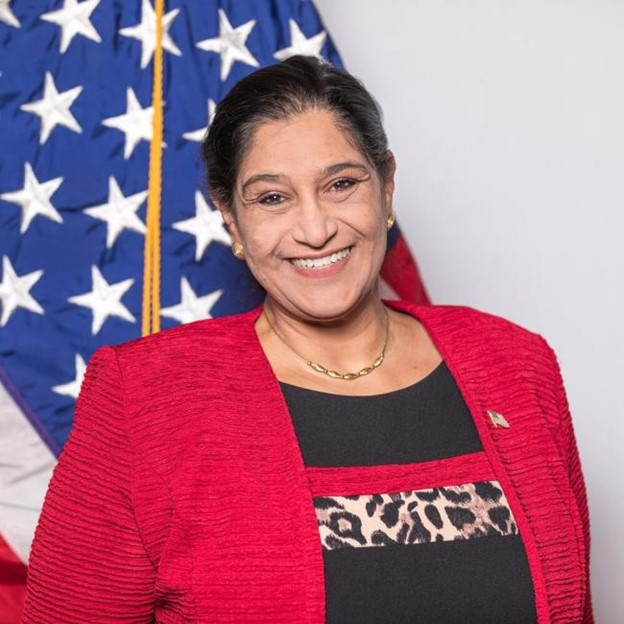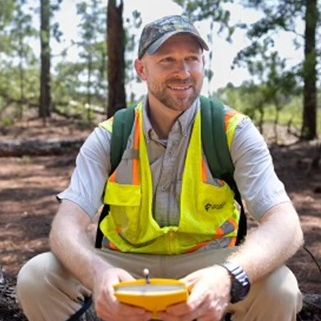Concurrent Sessions I | April 29 | 9:30 AM – 11:00 AM
Session 1.1 A
Geospatial | Advancing Permitting Timelines Through Rapid Geospatial and AI Analysis
9:30 AM – 10:00 AM
| About the Presentation |
|
Efficiently assessing permitting requirements is crucial in today's accelerated project timelines. This presentation introduces an innovative Esri geospatial application designed to streamline critical issue analysis, empowering project teams to expedite permitting assessments without compromising thoroughness. The application allows users to upload project boundaries for prompt spatial assessment, instantly comparing key environmental and regulatory datasets. This automated process produces comprehensive reports complete with metrics, tables, and a set of essential figures, delivering in minutes what would traditionally require extensive manual effort.
Enhanced with selective AI-driven insights, the tool refines raw data analysis to support permitting decisions, identifying critical patterns and environmental constraints that aid practitioners in prioritizing their next steps. This advancement reduces costs and enables project teams to respond promptly to regulatory requirements and environmental challenges, helping projects stay on track and aligned with regulatory expectations.
Attendees will gain insights into how this application reduces the operational demands of permitting, delivering efficiencies that empower professionals to make timely, informed decisions. This session will outline the core functionalities and provide examples of its application in various permitting contexts, underscoring the transformative impact of accelerated analysis and automated reporting on project outcomes.
Learning Objectives
The objective of this session is to demonstrate how streamlining the critical issue analysis process can expedite environmental permitting. By leveraging geospatial analysis and AI-powered insights, this approach reduces the time required to assess regulatory and environmental constraints, enabling faster, data-informed decisions. Attendees will learn how automation supports essential reporting tasks, from generating detailed metrics and tables to producing standard figures, significantly accelerating the permitting timeline. This session will highlight how streamlining critical issue analysis can enhance project efficiency, reduce costs, and align permitting processes with tight project schedules.
|
| About the Speaker(s) |
|

|
Kevin Murphy
Digital and Data Lead
Jacobs
Speaker Bio coming soon!
|
Session 1.1 B
Geospatial | Can Deep Learning Identify Disturbed Areas Throughout North Carolina?
10:00 AM – 10:30 AM
| About the Presentation |
|
Natural disturbances, such as wildfires and burns, play a crucial role in promoting plant diversity through the creation of open canopy spaces and the encouragement of understory growth. Over time, many plant species evolved to thrive in routinely fire-disturbed environments. However, the suppression of natural wildfires by humans has led to the decline of ecological niches created by fire disturbance, particularly across the eastern United States. Today, many species relying on disturbance are found in periodically mowed or maintained corridors such as transmission lines, road verges, and gas pipelines. These areas are managed intermittently, allowing for plant regrowth while preventing forest encroachment, making them ideal habitat for various threatened and endangered (T&E) species.
The North Carolina Department of Transportation (NCDOT) has taken on the challenge of identifying optimal habitats for various T&E species by developing a habitat prediction model using geospatial data. With the knowledge of how disturbed areas are critical for some T&E occurrences, ecologists are interested in better identifying disturbed habitats where T&E species often thrive. To enhance this habitat prediction model, Stantec is developing a machine-learning approach to systematically identify linear disturbances in forested landscapes. By utilizing publicly available orthoimagery, Stantec's model can accurately detect these disturbed areas across North Carolina. In this presentation, we will explore the importance of identifying T&E habitats, the role of disturbed areas in habitat prediction, and how machine learning can generate extensive, systematic datasets to support large ecological goals.
Learning Objectives
- The use and application of deep learning to solve ecological problems
- Deep learning methodologies within the ESRI framework and lessons learned
|
| About the Speaker(s) |
|

|
Jordan Bryant
Environmental Scientist
Stantec
As an environmental scientist, Jordan has experience across a broad range of sectors including traditional energy, renewable energy, and infrastructure as well as work with municipalities and developers. She brings an in-depth knowledge of geographic information systems (GIS), ecology, and environmental science and policy to projects. Jordan regularly uses her GIS skills to solve large-scale environmental and ecological problems, helping to reduce impacts on our communities and ecosystems. When she isn't busy with environmental projects, you'll likely find Jordan camping and hiking throughout Virginia or curled up with a good book and her cat, Ash.
|
|

|
Mehmet Secilmis, MS GISP
Senior Global Account Manager - AEC & Environmental
ESRI
Mehmet is the Senior Global Account Manager at Esri's Architecture, Engineering, Construction (AEC) and Environmental sector team in the USA. He has more than 20 years of diverse experience in civil/environmental engineering, GIS, and management. His educational background includes an MS degree in Environmental Technology and an MS degree in Management with a concentration in Management of Technology.
|
Session 1.1 C
NEPA | Advancing Permitting Excellence - Permitting Council Benefits and Resources for Infrastructure Projects
10:30 AM – 11:00 AM
| About the Presentation |
|
Federal permitting has historically suffered from inefficiencies and a lack of coordination and collaboration between agencies. To help address these challenges, in 2015, Congress passed the Fixing America’s Surface Transportation Act and, under Title 41 (FAST-41), established the Federal Permitting Improvement Steering Council (Permitting Council). The Permitting Council's foundational mission is to create transparency, predictability and accountability in the environmental review and permitting of infrastructure projects, keeping projects moving forward without cutting corners or reducing the rigor of analysis in environmental review. Attendees will learn about the Permitting Council structure, eligibility for FAST-41 coverage, the benefits and services provided by the Permitting Council’s dedicated infrastructure project advisors, and how environmental review and authorization timelines for FAST-41 projects are tracked and actively managed on the public-facing Permitting Dashboard. Participants will hear about how FAST-41 provides a seat at the table for project developers to understand the interdependencies of the permitting process and an opportunity for sponsors to engage with permitting agencies and have meaningful conversations about the permitting schedule. This helps everyone understand how a delay on one permit can have a cascading effect on project delivery by moving construction dates, labor availability, parts shipments and countless other factors beyond permitting that influence a project’s ultimate success. Attendees will learn that, beyond project focused support, the Permitting Council also serves as a federal center for permitting excellence - leveraging its experience with covered projects, agency convening power, and ability to inform programmatic solutions to help permitting across government.
Participants will learn about how the Permitting Council is forging new partnerships with states through FAST-41’s state “opt-in” provision, which gives states the unique opportunity to track and jointly manage a schedule of required state-level reviews and authorizations on the Permitting Dashboard. The presentation will highlight the Permitting Council’s Memorandum of Understanding with the New Mexico Renewable Energy Transmission Authority (RETA), which establishes a working relationship between the Permitting Council and RETA in order to provide federal permitting support to RETA-supported projects that also qualify for coverage under the Permitting Council’s FAST-41 program. This new, collaborative state-federal partnership will help bring the benefits of federal permitting assistance to New Mexico to bring consequential infrastructure projects to life.
Throughout the presentation, attendees will hear about real-world examples of FAST-41 projects from across sectors to demonstrate how the Permitting Council can unlock tools for a better permitting process, ultimately benefiting the U.S. economy, its environment, and its people.
At the conclusion of this presentation, attendees will:
- Have increased familiarity with the Permitting Council and FAST-41 and its benefits for improved permitting processes for covered projects
- Understand how FAST-41 facilitates relationship building and collaborative processes
- Recall examples of cutting-edge FAST-41 processes and practices that have demonstrated positive impacts on infrastructure permitting
- Be familiar with the state opt-in provision and unique opportunity for state-federal partnerships.
|
| About the Speaker(s) |
|

|
Manisha Patel, JD
Acting Executive Director
Federal Permitting Improvement Steering Council
Manisha Patel currently serves as the Acting Executive Director for the Permitting Council. Her permanent position is the Deputy Executive Director of the Permitting Council, bringing over twenty years of experience in crafting and implementing environmental policies for both public agencies and the private sector. She is known for her expertise in NEPA and has a strong track record in addressing complex environmental issues. Before joining the Permitting Council, Ms. Patel was a Vice President at WSP, a global engineering services firm, where she led the Environmental Process and Policy Practice Team to deliver major infrastructure projects.
|
Back to Top
Session 1.2
Biological Resources | Biological Resources Working Group's Regulatory Update- MBTA, ESA, BGEPA, and More
9:30 AM – 11:00 AM
| About the Presentation |
|
The Biological Working Group follows regulations such as the Endangered Species Act, Migratory Bird Treaty Act, Magnuson-Stevens Conservation and Management Act, Marine Mammal Protection Act, and Bald and Golden Eagle Protection Act, among others. This session will provide regulatory updates to what our team thinks are the most significant regulatory shifts that impact the environmental profession. Our presenters will provide insight into how these changes will affect the analysis and implementation of these statutes.
This session will:
- Provide timely and relevant information to the NAEP members
- Provide the highlights of the Biological Resources Working Group's regulatory updates from the year
- Provide awareness of the Biological Resources Working Group and grow our participation
|
| About the Moderator |
|

|
Nick Morgan
Director, Mitigation Solutions
The Conservation Fund
Nick Morgan focuses on developing and implementing compensatory mitigation projects and programs to offset impacts from infrastructure development across the United States. This includes mitigation for impacts to threatened and endangered species, historic and cultural resources, state and federal lands, and migratory birds. A popular mitigation fund that Nick’s team manages is the Range-wide Indiana Bat and Northern Long-eared Bat In-Lieu Fee Program, which was established in 2017.
|
| About the Speaker(s) |
|

|
Mike Mayer
Principal Environmental Project Manager
HDR
Mike has 20+ years of experience in environmental planning and project management and currently serves as a Principal Environmental Project Manager at HDR, Inc. and is the NAEP Biological Resources Working Group Lead. Mike has extensive experience on Federal environmental compliance projects around the U.S., including large-scale and controversial EISs and ESA consultations. He is a past Adjunct Instructor at the National Conservation Training Center.
|
 |
Megan Petraitis, MBA
Senior Program Manager – Conservation Agreements
University of Illinois Chicago – Energy Resources Center
Megan Petraitis is the Senior Program Manager of Conservation Agreements at the Energy Resources Center for the University of Illinois Chicago. Megan oversees the creation and establishment of conservation agreements including the nationwide Monarch Candidate Conservation Agreement and Bumble Bee Conservation Benefit Agreement. Megan has over 10 years of experience working in program implementation and conservation. She holds a Bachelor of Science in Environmental Health with a minor in Biology from Illinois State University and a Master of Business Administration from the University of Illinois Chicago..
|
 |
Will Ricks, MS, CWB
Senior Environmental Health and Safety Consultant
Duke Energy
Will is a Certified Wildlife Biologist that worked in game management from 2010 to 2016. Will started at Duke Energy in 2017 and moved to a focus on nongame regulatory compliance. Will works in the Duke Energy Natural Resources group that has responsibility in the Midwest, Carolinas, and Florida with a wide range of species including, monarch butterflies, Bald Eagles, Red-cockaded Woodpeckers, rare plants, and protected bats. As the Pollinator Working Group Lead, part of Will’s role is to lead Monarch Candidate Conservation Agreement with Assurances program.
|
Session 1.3 A
Cultural Resources | Staying on Track: Integrating NEPA and Section 106 on Transit Projects
9:30 AM – 10:30 AM
| About the Presentation |
|
The Metropolitan Council (the Council) is proposing to extend its light rail transit infrastructure from downtown Minneapolis to northwest metro communities in Minnesota, a 13-mile route called the METRO Blue Line Extension (BLE). The Project anticipates funding from the Federal Transit Administration (FTA). FTA and the Council published the Final Environmental Impact Statement (EIS) in July of 2016, for compliance with the National Environmental Policy Act (NEPA) and Minnesota Environmental Policy Act (MEPA). FTA signed a Record of Decision (ROD) in September of 2016. The measures FTA agreed to implement to avoid, minimize, and mitigate adverse effects on historic properties in compliance with Section 106 were documented in a Memorandum of Agreement (MOA), which was executed in August of 2016.
Approximately 7.8 miles of the project alignment was proposed to operate in BNSF right-of-way (ROW). Negotiations to secure needed right-of-way and other commitments to allow construction in the BNSF corridor were unsuccessful. In 2020, the Council and its partner, Hennepin County, in coordination with other project stakeholders and jurisdictions began to identify and evaluate potential alternative project routes to avoid use of BNSF ROW. A recommended modified route was adopted by the Council and Hennepin County in June 2022. The Council, under the direction of the FTA, is completing a Supplemental EIS/Amended ROD for the modified route for compliance with NEPA and MEPA. In addition, Section 106 consultation has been reopened and further studies have been completed to determine effects to historic properties.
To facilitate Section 106 compliance and preparation of the original 2016 Final EIS and subsequent Supplemental EIS, the project team developed an APE and defined research and survey methods, in close coordination with the Council and FTA. The team surveyed thousands of properties and completed scores of Phase II architecture/history evaluations, as well as assessed effects to archaeological resources and historic structures. HDR staff served as the Preservation Lead for the project during the Supplement EIS development, working closely with FTA and the Council to support the Section 106 process, as well as consultation with SHPO and other consulting parties. In addition, the project team worked closely with the design and engineering team to determine ways to minimize or avoid adverse effects and meet a tight timeline, particularly for the Supplemental EIS.
This project's successful approach to resource preservation and collaboration with FTA and the Council's environmental and design teams may serve as a model for future projects. Cultural Resource Preservation Best Practices: The project team's work with Metro Transit, Federal Transit Administration (FTA), and other stakeholders to address historic property impacts highlights effective methods for preserving cultural resources while advancing development. The recognition from the State Historic Preservation Office affirms the value of their approach, setting a standard for similar efforts in other projects. Environmental and Historic Preservation Compliance Model: By carefully navigating and aligning Section 106, NEPA, and Sections 4(f) and 6(f) compliance processes, the project exemplifies a balanced approach to infrastructure development that preserves significant natural and historic resources.
Interagency Collaboration: Demonstrates best practices in multi-agency cooperation, involving coordination with federal, state, and local stakeholders. Working closely with the FTA, State Historic Preservation Office, Metropolitan Council, as well as local preservation organizations and consulting parties, the team demonstrates a collaborative framework for overcoming regulatory hurdles, which may guide future large-scale infrastructure projects.
|
| About the Speaker(s) |
|

|
Lindsey Wallace
Sr. Architectural Historian and Planner
106 Group
Lindsey Wallace has over 15 years of professional experience working at the intersection of historic preservation, cultural resources, grant management, and community development. She is an expert in reviewing and evaluating compliance with the Secretary of the Interior’s Standards for the Treatment of Historic Properties, Section 106 of the National Historic Preservation Act, the National Environmental Policy Act, and local processes for issuing certificates of appropriateness. She collaborates frequently with federal, state, and local preservation and community development officials and partners, including State Historic Preservation Offices, and local historic preservation commissions.
|
|

|
Jennifer Bring
Environmental Section Manager
HDR
Jenny Bring has over 20 years of experience managing and contributing to a wide range of projects across the upper Midwest and nationwide, including transportation, renewable energy, transmission, and water infrastructure. Through her work, she has supported clients in strategic planning, environmental review/permitting, and meeting cultural resources requirements, particularly for compliance with the National Environmental Policy Act and Sections 106 and 110 of the National Historic Preservation Act, as well as state-level compliance requirements.
|
 |
Saleh Miller
Environmental Project Manager
HDR
Saleh Miller has almost 20 years of experience working on a wide range of projects across the Midwest and Mid-Atlantic, supporting federal, state, local, and private clients on transportation, water infrastructure, mining, and renewable energy projects. Her work has supported clients in strategic planning, preservation planning, and complying with cultural resources requirements, particularly with the National Environmental Policy Act, Sections 106 and 110 of the National Historic Preservation Act. Saleh has contributed to state and federal environmental documents and has prepared numerous technical studies. Saleh has served in the role of Principal Investigator for Architectural History on multiple transit projects and supported development of the BLE Supplemental EIS.
|
 |
Kelcie Young
Environmental Project Manager
Metro Transit
Kelcie Young joined Metro Transit, the public transportation agency for the Minneapolis-St Paul region in Minnesota, in 2015. She manages environmental reviews for the Green Line Extension and Blue Line Extension light rail projects and tracks mitigation commitments through construction. With over 15 years of experience as a NEPA practitioner, her focuses include navigating complex agency coordination and finding solutions to ensure projects serve community needs. Kelcie holds a Master of Urban and Regional Planning degree from the University of Minnesota Humphrey School and a Bachelor of Science degree in Conservation Biology and Political Science from the University of Wisconsin – Madison.
|
Session 1.3 B
Cultural Resources | Location Intelligence Software Streamlines Environmental and Historic Preservation Review Processes
10:30 AM – 11:00 AM
| About the Presentation |
|
Terracon's presentation will provide an overview on how the location intelligence software is being used to perform desktop environmental reviews for proposed broadband deployment projects for programs such as the Broadband Equity, Access, and Deployment (BEAD) Program. The BEAD Program provides billions of dollars of funding to expand high-speed internet access by funding planning, infrastructure deployment and adoption programs across the United States. The National Telecommunications and Information Administration (NTIA) administers the BEAD Program and requires that environmental and historic preservation reviews are performed prior to the funding of projects. These reviews include those required by the National Environmental Policy Act (NEPA), Section 106 of the National Historic Preservation Act (NHPA), Section 7 of the Endangered Species Act, Clean Water Act, etc.
Terracon will demonstrate how software streamlines the environmental and historic preservation review process by predicting the permitting complexity of a project using hundreds of state and federal databases. Utilizing location intelligence software, environmental and historic resources can be identified and impacts potentially avoided or minimized to reduce permitting load and streamline the environmental compliance process for stakeholders within the wireless industry. Terracon will discuss how location intelligence improves project implementation by informing stakeholders where additional information will need to be collected on site and what categorical exclusions may be utilized for a particular project.
Educate the audience on the use of location intelligence software in identifying and avoiding key environmental and historic preservation issues associated with NEPA/EHP projects. Educate the audience on federal funding and permitting requirements.
|
| About the Speaker(s) |
|

|
Emily Kosmalski, AICP, Environmental Professional
Principal, Environmental Planning Manager
Terracon Consultants, Inc.
Emily has over 18 years of experience performing Environmental Planning and Impact Assessment services under the National Environmental Policy Act (NEPA) for a wide variety of lead federal agencies. She specializes in telecommunications, broadband, solar, and other forms of digital infrastructure regulation. Emily leads a multi-disciplinary team of cultural and natural resource specialists who work together for the purposes of evaluating environmental impacts that may result from proposed federal undertakings as well as a national program, coordinating with numerous resource specialists companywide. Emily and her team have provided environmental and historic preservation reviews on thousands of broadband, fiber, and telecommunications projects nationwide.
|
|

|
Ben Browning
Staff Scientist
Terracon Consultants
Speaker info coming soon!
|
Back to Schedule
|